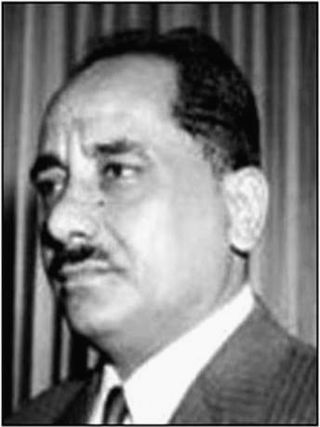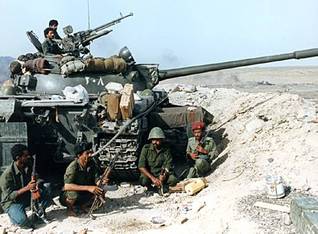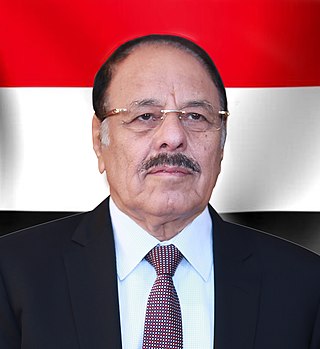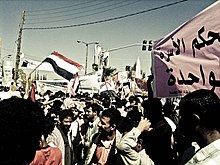
The history of Yemen describes the cultures, events, and peoples of what is one of the oldest centers of civilization in the Near East. Its relatively fertile land and adequate rainfall in a moister climate helped sustain a stable population, a feature recognized by the ancient Greek geographer Ptolemy, who described Yemen as Eudaimon Arabia meaning "fortunate Arabia" or "Happy Arabia". Yemenis had developed the South Arabian alphabet by the 12th to 8th centuries BC, which explains why most historians date all of the ancient Yemeni kingdoms to that era.

The Politics of Yemen are in an uncertain state due to the Houthi takeover in Yemen. An armed group known as the Houthis or Ansar Allah seized control of the Northern Yemeni government and announced it would dissolve parliament, as well as install a "presidential council", "transitional national council", and "supreme revolutionary council" to govern the country for an interim period. However, the deposed president, Abdrabbuh Mansur Hadi, has declared he is still in office and is working to establish a rival government in Aden.

The Yemeni Armed Forces are the military forces of the Republic of Yemen. They include the Yemeni Army, Yemeni Navy and the Yemeni Air Force. The capital of the country, Sana’a is where the military is headquartered. Per the constitution of Yemen, the President of Yemen serves as the commander-in-chief.

Aden is a port city located in Yemen in the southern part of the Arabian peninsula, positioned near the eastern approach to the Red Sea. It is situated approximately 170 km east of the Bab-el-Mandeb strait and north of the Gulf of Aden. With its strategic location on the coastline, Aden serves as a gateway between the Red Sea and the Arabian Sea, making it a crucial maritime hub connecting Africa, Asia, and the Middle East. As of 2023, Aden City has a population of approximately 1,080,000 residents, making it one of the largest cities in Yemen.

Yemen, officially the Republic of Yemen, is a sovereign state in West Asia. Located in the southern Arabian Peninsula, it borders Saudi Arabia to the north, Oman to the northeast, and the Indian Ocean to the south, sharing maritime borders with Eritrea, Djibouti and Somalia across the Horn of Africa. Covering roughly 528,000 square kilometres, with a coastline of approximately 2,000 kilometres, Yemen is the second largest country on the Arabian Peninsula. Sanaa is its constitutional capital and largest city. Yemen's estimated population is 34.7 million, comprised mostly of Arab Muslims. It is a member of the Arab League, the United Nations, the Non-Aligned Movement and the Organisation of Islamic Cooperation.

The Yemeni Arab Republic, commonly known as North Yemen or Yemen (Sanaʽa), was a country that existed from 1962 to 1990 in the northwestern part of what is now Yemen. Its capital was at Sanaa. It united with the People's Democratic Republic of Yemen on 22 May 1990 to form the current Republic of Yemen.

South Yemen, officially the People's Democratic Republic of Yemen, officially abbreviated to Democratic Yemen, was a state that existed from 1967 to 1990 as the only communist state in the Middle East and the Arab world. It was made up of the southern and eastern governorates of the present-day Republic of Yemen, including the island of Socotra. It was bordered by North Yemen to the North-West, Saudi Arabia to the North, and Oman to the East.

Qahtan Muhammad al-Shaabi was the first President of the People's Republic of South Yemen. Al-Shaabi's National Liberation Front (NLF) political organisation wrested control of the country from the British and won political supremacy over the opposition Front for the Liberation of Occupied South Yemen (FLOSY) in 1967. On 30 November 1967, the Protectorate of South Arabia was declared independent as the People's Republic of South Yemen, with al-Shaabi as President. Al-Shaabi held the presidency until 22 June 1969, when a hard-line Marxist group from within his own NLF seized control. He was replaced by Salim Rubai Ali and jailed, then placed under house arrest until the 1970s, and lived quietly in Aden from his release until his death in 1981.
As-Sayyid Abd Al-Rahman Ali Al-Jifri is a Yemeni opposition leader. He was the vice-president of the Presidency Council of the short-lived Government of the Democratic Republic of Yemen that was established on May 21, 1994. He was also the President of the National Opposition Front (MOWJ), the opposition group that fought and lost the brief war of secession against the Republic of Yemen in 1994. As of 2013 he was the Chairman of MOWJ, comprising the group of former socialist leaders who fled the country in 1994.

The Yemeni Socialist Party is a political party in Yemen. A successor of Yemen's National Liberation Front, it was the ruling party in South Yemen until Yemeni unification in 1990. Originally Marxist–Leninist, the party has gradually evolved into a social democratic opposition party in today's unified Yemen.

Yemeni unification took place on May 22, 1990, when the People's Democratic Republic of Yemen was united with the Yemen Arab Republic, forming the Republic of Yemen.

In the years after the September 11, 2001 attack on the World Trade Center in New York City, Yemen became a key site for U.S. intelligence gathering and drone attacks on Al-Qaeda. According to the 2012 U.S. Global Leadership Report, 18% of Yemenis approved of U.S. leadership, with 59% disapproving and 23% uncertain. According to a February 2015 report from the Congressional Research Service, U.S. officials considered Al-Qaeda in the Arab Peninsula the Al-Qaeda affiliate "most likely to attempt transnational attacks against the United States."

The Yemeni Civil Warof 1994, also known as the 1994 Summer War, was a civil war fought between the two Yemeni forces of the pro-union northern and the socialist separatist southern Yemeni states and their supporters. The war resulted in the defeat of the southern separatists and the reunification of Yemen, and the flight into exile of many leaders of the Yemeni Socialist Party (YSP) and other separatists.

The National Liberation Front was a Marxist paramilitary organization and a political party operating in the Federation of South Arabia, during the Aden Emergency. During the North Yemen Civil War, fighting spilled over into South Yemen as the British attempted to establish an autonomous colony known as the Federation of South Arabia. Following the exit of the British armed forces, the NLF seized power from its rival, the Arab nationalist Front for the Liberation of Occupied South Yemen (FLOSY). In the aftermath of the Emergency, the NLF renamed itself the National Front and eventually became the main force behind the creation of the Yemeni Socialist Party which subsequently governed the country as a single-party Marxist-Leninist state.

Abdrabbuh Mansur Hadi is a Yemeni politician and former field marshal of the Yemeni Armed Forces who served as the president of Yemen from 2012 until 2022, when he stepped down and transferred executive authority to the Presidential Leadership Council, with Rashad al-Alimi as its chairman. He was the vice president to Ali Abdullah Saleh from 1994 to 2012.

Ali Mohsen Saleh al-Ahmar, sometimes spelled Muhsin, is a Yemeni military officer who served as the vice president of Yemen from 2016 to 2022, when he was dismissed by President Abdrabbuh Mansur Hadi, who transferred the powers of the president and vice president to the Presidential Leadership Council. He is a general in the Yemeni Army and was the commander of the northwestern military district and the 1st Armoured Division. He played a leading role in the creation of the General People's Congress.

The South Yemen Civil War, colloquially referred to as The Events of '86 or The Events of January 13, or more simply as The Events, was a failed coup d'etat and armed conflict which took place on January 13, 1986, in South Yemen. The civil war developed as a result of ideological differences, and later tribal tensions, between two factions of the ruling Yemeni Socialist Party (YSP), centred on Abdul Fattah Ismail's faction, at-Toghmah, and Ali Nasir Muhammad's faction, az-Zomrah, for the leadership of the YSP and the PDRY. The conflict quickly escalated into a costly civil war that lasted eleven days and resulted in thousands of casualties. Additionally, the conflict resulted in the demise of much of the Yemeni Socialist Party's most experienced socialist leadership cadre, contributing to a much weaker government and the country's eventual unification with North Yemen in 1990.
The al-Waziri coup, also referred as the Yahya clan coup was a violent dynasty overthrow attempt in the Mutawakkilite Kingdom of Yemen in 1948, which caused around 5,000 fatalities. During the coup attempt, Imam Yahya Muhammad Hamid ed-Din, the ruler of the kingdom, was killed and the rival Sayyid family, the al-Wazirs, seized power for several weeks. Backed by the al-Saud family of Saudi Arabia, the Hamidaddins restored their rule. After the al-Wazirs were deposed, Imam Yahya's monarchy was restored with his son, Ahmad bin Yahya, ascending the throne.

The Second Yemenite War was a short military conflict between the Yemen Arab Republic and the People's Democratic Republic of Yemen. The war developed out of a breakdown in relations between the two countries after the president of North Yemen, Ahmad al-Ghashmi, was killed on 24 June 1978, and Salim Rubai Ali, a moderate Marxist who had been working on a proposed merger between the two Yemens, was murdered two days later. The hostility of the rhetoric from the new leadership of both countries escalated, leading to small scale border fighting, which then in turn escalated into a full blown war in February 1979.

The aftermath of the Houthi takeover in Yemen refers to developments following the Houthis' takeover of the Yemeni capital of Sana'a and dissolution of the government, which eventually led to a civil war and the Saudi Arabian-led intervention in Yemen.




















